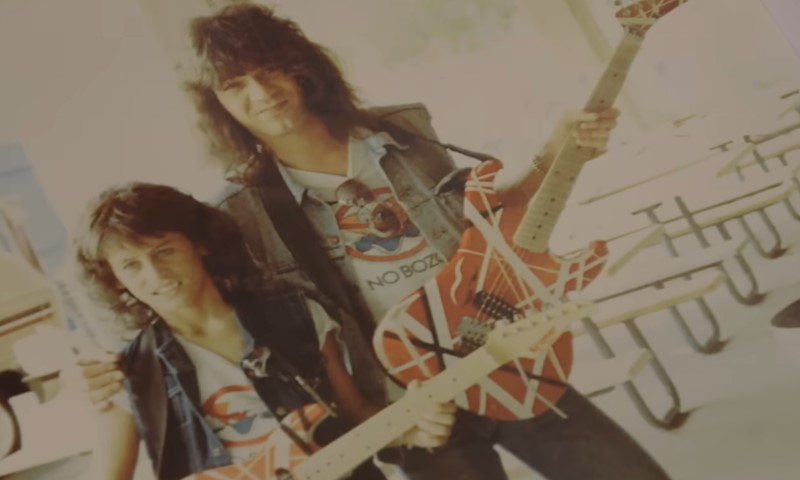In the late 1970s, rock music was full of loud guitars and wild solos, but nobody sounded like Eddie Van Halen. He didn’t just play differently; he thought differently. His guitar wasn’t a polished showroom model or a rare collectible; it was something he built himself, from mismatched parts, paint, and a lot of instinct.
The result, known today as the Frankenstrat, didn’t just change how guitars looked or sounded. It redefined how musicians approached their instruments and how innovation could come from a garage rather than a factory.
The Search for the Perfect Sound
Eddie’s problem was simple but maddening: he loved the smooth playability of a Fender Stratocaster but wanted the thick, growling tone of a Gibson Les Paul. No company at the time offered that combination. He had two choices: settle for “close enough,” or take a chisel to wood and make something entirely new. Naturally, Eddie chose the latter.
He started small. For around $130, he ordered a bare Strat-style body and neck from Boogie Bodies, a supplier known for selling imperfect guitar parts. Most musicians would have rejected them immediately, tiny cracks, warped grain, rough edges, but Eddie didn’t care. To him, tone was about feel, not perfection.
Building the Monster
Eddie’s garage in Pasadena turned into his workshop. He didn’t have a luthier’s training or a blueprint, just imagination and a few tools. He sanded, cut, and drilled until the body felt right in his hands. For the pickup, he cannibalized an old Gibson PAF humbucker from a junked ES-335 and wired it into the single-pickup slot of the Strat body. Then, in classic Van Halen style, he tilted it at an angle, partly because it fit better, but also because it gave the high strings extra bite and the low strings more warmth.
The paint job came next, white first, then layers of black, and finally red, each coat separated by masking tape to form those iconic jagged stripes. None of it was planned. Eddie once said he just wanted something that looked “cool.” Ironically, the accidental design became one of the most recognized visuals in rock history.
Even the details were chaotic genius. One of the knobs didn’t actually connect anything; ing, it was glued on for looks. The pickguard was cut by hand. He jammed the tremolo system together from spare parts. He poured paraffin wax on the pickup to stop it from squealing at high volume. Every flaw, every shortcut, gave the Frankenstrat more character and more edge.
A Tone No One Had Heard Before

When people first heard “Eruption,” they thought it was studio trickery. The tone was sharp, explosive, and alive. Eddie’s two-handed tapping technique, rapidly hammering notes with both hands, sounded like a synth and a guitar fused into one instrument. But the magic wasn’t just his fingers; it was the Frankenstrat.
The combination of a humbucker pickup, light Strat body, and tremolo bridge created a sound that was both aggressive and elastic. The guitar could scream, whisper, or cry without losing clarity. It broke all the traditional “rules” of tone design, and players around the world took notice.
By the early ’80s, guitar makers like Jackson, Charvel, and Kramer were scrambling to build “Super Strat” models that copied Eddie’s formula. He had started a revolution from his garage, one hacksaw cut at a time.
Eddie’s Workshop Philosophy
Eddie Van Halen wasn’t just a guitarist; he was a tinkerer. He believed in learning by breaking things. He filed frets himself, drilled holes into brand-new guitars, and tested tonewoods by ear. “If it feels right, it is right,” he once said.
His curiosity was his power. He never waited for someone else to design the perfect guitar or amp. He went ahead and did it himself. That same mindset drives countless creators today, people who turn standard tools into personal masterpieces. Whether you’re modifying a guitar, a motorbike, or a 3D printer, that desire to make something yours is the real art.
It’s why modern creators still connect to that same spirit. A musician shaping his tone with a soldering iron isn’t that different from an artist customizing materials with precision tools like a TOOCAA laser engraver. Both acts come from the same place, taking what exists and reshaping it to match your own vision. It’s creative rebellion, and it’s exactly what Eddie embodied.
An Icon Is Born

When Van Halen exploded onto the scene, and it became very popular bend, the Frankenstrat became a visual signature as much as a sonic one. Under stage lights, its jagged stripes seemed alive, flashing red and black as Eddie dove on his whammy bar. Fans and gearheads obsessed over every scratch, trying to replicate his sound and look. Fender even reissued exact replicas decades later, complete with cigarette burns and mismatched parts.
But the real power of the Frankenstrat was never its price tag or its paint; it was its philosophy. It was proof that mastery and invention don’t need permission. That imperfection can be genius when it’s fueled by curiosity.
Legacy and Influence
View this post on Instagram
Eddie’s impact went far beyond the guitar community. He changed how musicians saw their relationship with gear. Before him, guitars were sacred objects, crafted by experts, bought by players. After him, they became playgrounds for experimentation. Suddenly, guitarists were swapping pickups, rewiring circuits, cutting necks, and chasing tone in their own garages.
Eddie also influenced amp design, pushing companies like Peavey and EVH Gear to develop high-gain amplifiers that could match his playing dynamics. Even decades later, his ideas still power the foundation of modern rock, metal, and fusion music.
The Man, the Machine, the Message
Eddie Van Halen passed away in 2020, but his spirit remains in every DIY musician who refuses to accept limits. The Frankenstrat wasn’t perfect; it buzzed, cracked, and sometimes went out of tune, but that was the point. It was alive. It represented the belief that innovation comes from hands, not factories.
His guitar now hangs in the Smithsonian, a symbol of American creativity, proof that passion and experimentation can shape an entire generation’s sound. Eddie never built the Frankenstrat to be iconic. He built it because he had to. Because the sound in his head didn’t exist yet.
And maybe that’s the real lesson: whether you’re wiring a pickup or engraving your next design, the magic begins when you stop waiting for the perfect tool and start creating your own.
- Pop Stars With The Most Valuable Memorabilia In 2025: Collector List - December 23, 2025
- Music Stars Who Advocated For Better Healthcare For Children - December 20, 2025
- Noel Gallagher Biography – The Songwriter Who Defined Britpop - December 11, 2025



